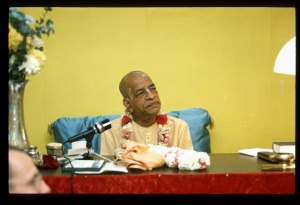CC Madhya 9.82 (1975)

A.C. Bhaktivedanta Swami Prabhupada
TEXT 82
- śrī-vaiṣṇava eka,--'vyeṅkaṭa bhaṭṭa' nāma
- prabhure nimantraṇa kaila kariyā sammāna
SYNONYMS
śrī-vaiṣṇava eka—a devotee belonging to the Rāmānuja-sampradāya; vyeṅkaṭa bhaṭṭa—Veṅkaṭa Bhaṭṭa; nāma—named; prabhure—unto Lord Caitanya Mahāprabhu; nimantraṇa—invitation; kaila—did; kariyā—offering; sammāna—great respect.
TRANSLATION
One Vaiṣṇava known as Veṅkaṭa Bhaṭṭa then invited Śrī Caitanya Mahāprabhu to his home with great respect.
PURPORT
Śrī Veṅkaṭa Bhaṭṭa was a Vaiṣṇava brāhmaṇa and an inhabitant of Śrī Raṅga-kṣetra. He belonged to the disciplic succession of Śrī Rāmānujācārya. Śrī Raṅga is one of the places of pilgrimage in the province of Tāmil Naduś. The inhabitants of that province do not retain the name Veṅkaṭa. It is therefore supposed that Veṅkaṭa Bhaṭṭa did not belong to that province, although he may have been residing there for a very long time. Veṅkaṭa Bhaṭṭa was in a branch of the Rāmānuja-sampradāya known as Baḍagala-i. He had a brother in the Rāmānuja-sampradāya known as Śrīpāda Prabodhānanda Sarasvatī. The son of Veṅkaṭa Bhaṭṭa was later known in the Gauḍīya-sampradāya as Gopāla Bhaṭṭa Gosvāmī, and he established the Rādhāramaṇa temple in Vṛndāvana. More information about him may be found in a book known as Bhakti-ratnākara, by Narahari Cakravartī.